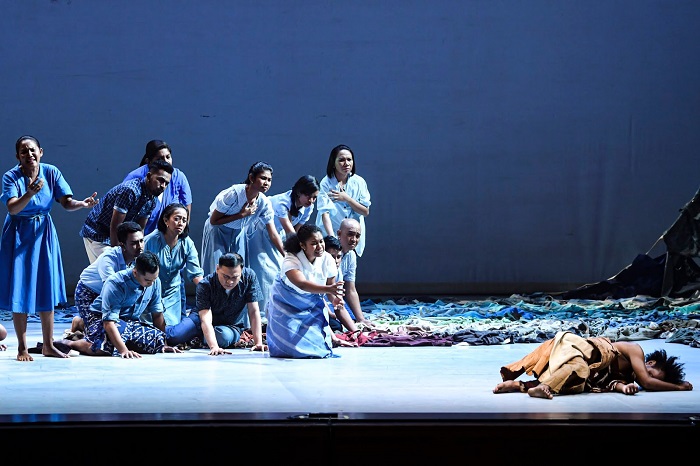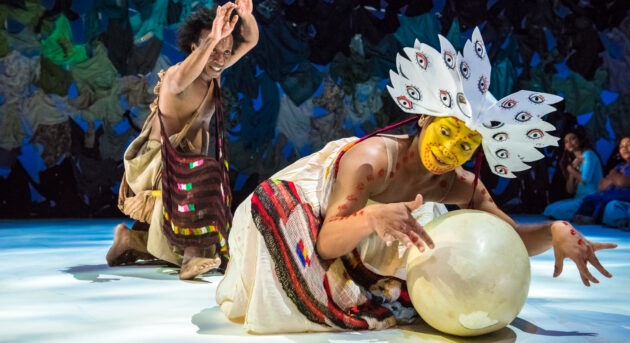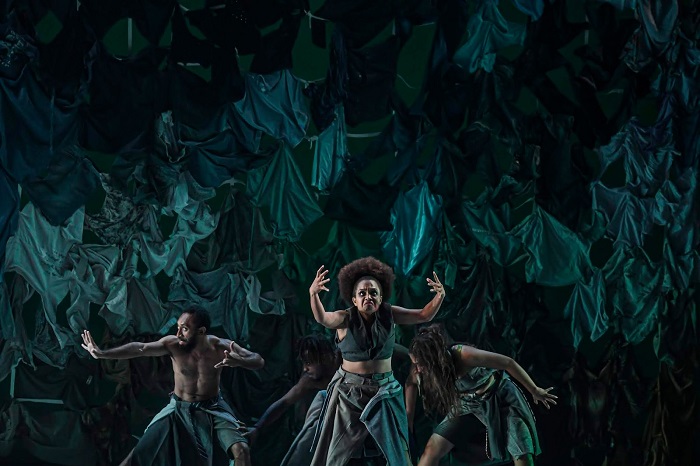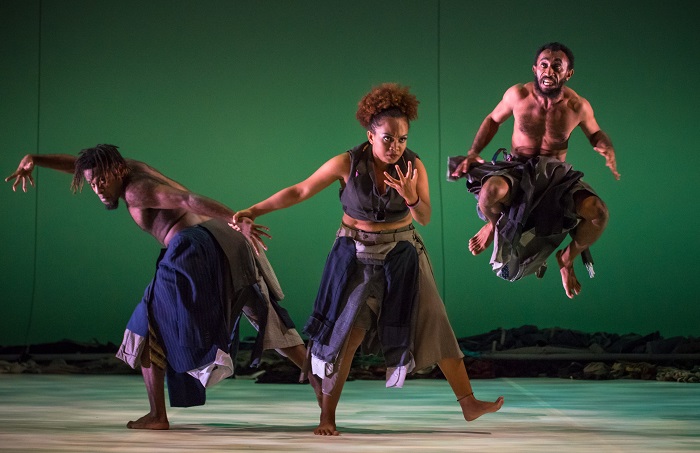Garin Nugroho’s major theatrical work inadvertently reveals the challenges in representing race in cross-cultural collaboration
Wulan Dirgantoro
The largest performing arts triennial in the Asia Pacific (AsiaTOPA), organised by Arts Centre Melbourne, ran its second iteration from January 2020 until its premature closure on March 16 when the state government of Victoria announced the state of emergency COVID-19 pandemic. The 2020 Asia-Pacific Triennial of Performing Arts coincided with the beginning of a global pandemic and at the tail end of a catastrophic bushfire season in Australia.
The 2019-20 Australian bushfire was unprecedented in its scale and ferocity; these intense fires devastated communities, destroyed wildlife populations and left many feeling empty and overwhelmed. Scientists have warned that climate change aggravated by human actions drives the climate disaster in Australia and other parts of the world. Garin Nugroho’s The Planet: A Lament, premiered at the 2020 Asia TOPA addressed this issue through the lens of ecological grief and featuring a cast from Eastern Indonesia.
The play
The Planet: A Lament was a performance piece directed by Garin Nugroho, the noted Indonesian film director. Planet was structured around a song cycle, composed and performed by a Papuan soloist, Septina Rosalina Layan. Layan’s ten beautiful compositions were accompanied by an award-winning chorale, Mazmur Chorale from Kupang, East Nusa Tenggara and a team of dancers from Papua. Nugroho worked together with his artistic team and collaborators in Indonesia and Australia to deliver a piece that deftly woven his trademark cinematic style with songs and live dance that told the story of a community in the aftermath of natural disaster.

The performance opened with the soloist, Layan herself, wearing a noken (woven bag) headgear and a light blue dress, singing her haunting song. From the left and right of the stage, the chorale members appeared and accompanied the soloist with harmony. As they sang, an invisible pulley system pulled the blue floor covering towards the roof to resemble a rising wave. The ‘wave’ was made from clothes that were carefully sewn together and evoked the devastating loss from the Boxing Day tsunami in 2004 that Nugroho cited as his inspiration for the piece.
As the soloist and chorale withdrew, a man appeared on the stage. The soloist then returned and handed him a large egg. The egg was seen as a symbol of hope and rebirth, and the man carried the egg through post-apocalyptic landscapes projected on a screen behind him. As the egg carrier traversed different landscapes, a trio of dancers appeared. The dancers represented 'The Eaters', who are 'monsters, born out of mud and destruction' as explained by Nugroho.
A large golden bird, performed by Rianto, the dancer in Nugroho’s ‘Kucumbu Tubuh Indahku’ (Memory of My Body, 2017), then appeared to help the carrier and protect the egg. In some of the lighter moments of the performance, the bird danced together with the carrier with tender intimacy. As the carrier passed on the egg to the bird, the eaters appeared to seize the egg; the carrier then sacrificed himself to the eaters to protect the egg and the bird. The soloist and the choir lament the carrier’s death and look towards the egg as a symbol for a new beginning.
Ecological grief
Garin Nugroho was moved to create the piece after witnessing over the past five years an increasing amount of climate disasters from floods to earthquake, and to the recent pandemic across Indonesia. In seeking to understand how different communities respond to these disasters, Nugroho turned towards traditional ritual and performances across the archipelago and discovered the lament singing tradition. Lament singing is a centuries-old practice from Christian communities in Eastern Indonesia. Stories of life, death, war and disaster are set in pentatonic notes and sung at religious events and funerals. According to Nugroho and Layan, lament singing is the perfect vehicle to express deep feelings of grief, and in this context, the loss of connection with the environment.

The term ‘ecological grief’ describes ‘the grief, pain, sadness, or suffering’ people feel due to the loss or anticipated loss of precious ecosystems, species and places. They can be thought as both personal losses as well as collective losses of a group. Scholars Ashlee Cunsolo and Neville R. Ellis explain that ecological grief can be expressed through mental and emotional reactions such as ‘sadness, distress, despair, anger, fear, helplessness, hopelessness, depression, pre- and post-traumatic stress.’
While humans have caused large-scale change to natural environments for a long time, the current scope and pace of change is unprecedented, and society has not yet fully developed rituals and practices to help people express their emotions. Some countries have begun to take steps towards environmental personhood. For example, the Whaitangi river in New Zealand is acknowledged as a living entity. Such steps can be seen to sustain association with places and practices that are damaged, threatened or have been lost. In creating such environmental personhood, many traditional communities can increase their protection towards culturally significant areas and create rituals to help people manage ecological grief and heal from ecological losses in the same way that it has for human losses.
Planet is one such contemporary example from Indonesia, where community grief caused by climate disaster and loss of connection with the land are expressed through art. Despite his background as a film director, Nugroho believes that theatre is the right method to convey this sense of loss, as it allows the audience to feel more and connect more with the raw emotion presented in the piece. Layan also notes that lament singing came from the depth of a shared tradition and shared emotion to express grief together with the other performers from Eastern Indonesia.
Limits of representation?
The strong focus on Eastern Indonesian performers and cultures was important for this production. After focusing on Javanese culture in his previous production Setan Jawa for the 2017 Asia TOPA, Planet was a turning point for Nugroho to communicate the impact of climate change on traditional communities and First Nations people across the globe. In delivering the complex message, Nugroho constructed a multilayered web of song, dance and visual symbols in the performance, but at times, these elements are unevenly distributed.
The final scene that involved the characters known as ‘The Eaters’ was one of them. The dancers, Serraimere Boogie, Heinbertho J.B.D. Koirewoa (Douglas), Pricillia Elisabeth Monica (Elis) and Paul Amandus Dwaa (Becham) came from different parts of Papua and West Papua; Sorong, Sentani and Jayapura. Their skills and high energy were derived from the local dance and hip-hop scene in Papua and formal training in the Jakarta Art Institute in the case of Boogie. The dancers’ skilful moves and powerful presence on stage, are at the centre of this piece, as both the protagonist (Boogie as the egg carrier) and the antagonists (Douglas, Elis and Becham as the eaters).

As the egg carrier sacrificed himself in the final scene, the eaters latched on various body parts and proceeded to ‘eat’ him. As the character’s name indicated, they represent the impact of pollution and human greed on the Planet. Nonetheless, such portrayal evoked stereotypes of Papuan bodies as ‘polluted, dangerous and uncontrollable’ prevalent in state and popular discourse. Five months before Planet premiered in Jakarta and Melbourne, in August 2019, large riots broke out in several cities in Papua and West Papua triggered by racial slurs thrown to Papuan students by militias in Surabaya. Moreover, it also evoked the older, uglier stereotypes of Papuans as primitive and allegedly still practising anthropophagy or human cannibalism. As Nugroho has explained elsewhere, the focus on Melanesian culture in the play was intended to elevate the region’s wealth of natural talent through storytelling. At the same time, however, it brings into focus the challenges of articulating the issue of race and representation even from a renowned storyteller.
Planet opens the possibilities of connecting different communities with ecological loss and grief through the senses, instead through a complete and fully understood narrative, as one critic expected. As the wider communities within and outside Indonesia only began to absorb these narratives of ecological loss, despite its questionable portrayal of Papuans, Planet’s carefully constructed world articulated the emotions that touched the pulse of audiences Australia (and around the world) in the midst of a climate crisis.
Wulan Dirgantoro is a McKenzie Postdoctoral Fellow at the School of Culture and Communication, the University of Melbourne.
